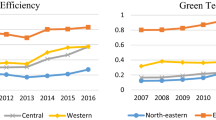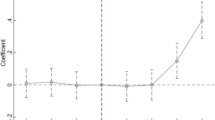Abstract
Green innovation (GI) is an important means of achieving a win-win outcome in the form of both economic development and environmental protection. Using a unique Chinese Patent Census Database to identify the quantity and quality of GI in each province and panel data for Chinese industrial sector in 30 provinces from 2002 to 2015, we investigated the impact of environmental regulation (ER) on GI in China. This study presents the first attempt to identify green innovation quality in China. Empirical results show that there is an inverted-U relationship between ER and GI. The heterogenous effects are further investigated in order to obtain more accurate policy implications. The results indicate that the impact of ER on GI is insignificant in the central and western regions, implying the necessity of adjusting ER policies in these regions. Second, the inverted U-shaped relationship between ER and GI only occurred in provinces with high state-owned enterprise (SOE) ratio, figuring out the special role of Chinese SOEs in promoting GI. Third, the impact of ER on GI is insignificant in regions with high levels of pollution, indicating high potential of green innovation and policy adjustments there.
Similar content being viewed by others
Availability of data and materials
The datasets generated and/or analyzed during the current study are not publicly available due to the confidentiality agreement of the patent data, but are available from the corresponding author on reasonable request.
References
Aghion P, Reenen JV, Zingales L (2013) Innovation and institutional ownership. Am Econ Rev 103:277–304
Alpay E, Buccola S, Kerkvliet J (2002) Productivity growth and environmental regulation in Mexican and U.S. food manufacturing. Am J Agric Econ 84:887–901
Bessen J, Bessen EJ, Meurer MJ (2008) Patent failure: how judges, bureaucrats, and lawyers put innovators at risk. Princeton University Press, New Jersey ISBN 978-0691134918-352
Brunnermeier SB, Cohen MA (2003) Determinants of environmental innovation in US manufacturing industries. J Environ Econ Manag 45:278–293
Cai J, Chen Y, Wang X (2018) The impact of corporate taxes on firm innovation: Evidence from the corporate tax collection reform in China. NBER Working Paper, Article ID 25146, 43 pages
Cai X, Zhu B, Zhang H, Li L, **e M (2020) Can direct environmental regulation promote green technology innovation in heavily polluting industries? Evidence from Chinese listed companies. Sci Total Environ 746:140810 14 pages
Cheng W, Yang Z, Pan X, Baležentis T, Chen X (2020) Evolution of carbon shadow prices in China’s industrial sector during 2003–2017: a by-production approach. Sustainability 722, 14 pages
Domazlicky BR, Weber WL (2004) Does environmental protection lead to slower productivity growth in the chemical industry. Environ Resour Econ 28:301–324
Du J, Peng S, Song W, Peng J (2020) Relationship between enterprise technological diversification and technology innovation performance: moderating role of internal resources and external environment dynamics. Transform Bus Econ 19(2):52–73
Fedulova S, Komirna V, Naumenko N, Vasyliuk O (2019) Regional development in conditions of limitation of water resources: correlation interconnections. Montenegrin J Econ 14(4):57–68
Ge Y, Hu Y, Ren S (2020) Environmental regulation and foreign direct investment: evidence from China’s eleventh and twelfth five-year plans. Sustainability 2528, 18 pages
Gilbert R, Shapiro C (1990) Optimal patent length and breadth. RAND J Econ 21:106–112
Gray WB (1987) The cost of regulation: OSHA, EPA and the productivity slowdown. Am Econ Rev 77:998–1006
Hamamoto M (2006) Environmental regulation and the productivity of Japanese manufacturing industries. Resour Energy Econ 28:299–312
He Z, Tony TW, Zhang Y, He W (2018) A database linking Chinese patents to China’s census firms. Nat Sci Data 5:180042
Hu J, Wang Z, Huang Q, Zhang X (2019) Environmental regulation intensity, foreign direct investment, and green technology spillover—an empirical study. Sustainability 2718, 15 pages
Jaffe A, Palmer K (1997) Environmental regulation and innovation: A panel data study. Rev Econ Stat 4:610–619
Jerónimo Silvestre W, Antunes P, Leal Filho W (2018) The corporate sustainability typology: analysing sustainability drivers and fostering sustainability at enterprises. Technol Econ Dev Econ 24(2):513–533
Ji Z, Li P, Zheng X (2019) Manufacturing Agglomeration and Environmental Efficiency in China: Insights from the Panel Threshold Model. Transform Bus Econ 18(1):257–277
Jiang F, Wang Z, Bai J (2013) The dual effect of environmental regulations’ impact on innovation: an empirical study based on dynamic panel data of Jiangsu manufacturing. China Ind Econ 7:44–55
Kneller R, Manderson E (2012) Environmental regulation and innovation activity in UK manufacturing industries. Resour Energy Econ 34:211–235
Lanoie P, Patry M, Lajeunesse R (2008) Environmental regulation and productivity: testing the Porter hypothesis. J Prod Anal 30:121–128
Li D, Zhu J (2019) The role of environmental regulation and technological innovation in the employment of manufacturing enterprises: Evidence from China. Sustainability 2982
Li J, Zhao M, Yang Y (2019a) Environmental regulation and firms’ performance: a quasi-natural experiment from China. Chin J Popul Resour Environ 17(3):278–294
Li J, Ji J, Zhang Y (2019b) Non-linear effects of environmental regulations on economic outcomes. Manag Environ Qual Int J 30(2):368–382
Li Y, Ding L, Yang Y (2020) Can the introduction of an environmental target assessment policy improve the TFP of textile enterprises? A quasi-natural experiment based on the Huai River Basin in China. Sustainability 1696
Lin Y, Tan G (1999) Policy burdens, accountability and soft budget constraint. Am Econ Rev 89:426–431
Liu J, **e J (2020) Environmental regulation, technological innovation, and export competitiveness: an empirical study based on China’s manufacturing industry. Int J Environ Res Public Health 1427, 19 pages
Porter ME (1991) America’s Green Strategy. Sci Am 264:193–246
Porter ME (1992) Capital disadvantage: America’s failing capital investment system. Harv Bus Rev 70:65–82
Porter ME, Linde CVD (1995) Toward a new conception of the environment-competitiveness relationship. J Econ Perspect 9:97–118
Rassier DG, Earnhart D (2010) Does the Porter hypothesis explain expected future financial performance? The effect of clean water regulation on chemical manufacturing firms. Environ Resour Econ 45:353–377
Rubashkina Y, Galeotti M, Verdolini E (2015) Environmental regulation and competitiveness: empirical evidence on the Porter hypothesis from European manufacturing sectors. Energy Policy 83:288–300
Shan W, Wang J (2019) The effect of environmental performance on employment: evidence from China’s manufacturing industries. Int J Environ Res Public Health 2232, 18 pages
Shen N, Liu F (2012) Can intensive environmental regulation promote technological innovation? Porter hypothesis reexamined. China Soft Sci 4:49–59
Song M, Wang S, Zhang H (2020) Could environmental regulation and R&D tax incentives affect green product innovation. J Clean Prod 120849
Teng X, Liang C, Chiu YH (2019) Energy and emission reduction efficiency of China’s industry sector: A non-radial directional distance function analysis. Carbon Manag 10:333–347
Wagner M (2007) On the relationship between environmental management,environmental innovation and patenting: evidence from German manufacturing firms. Res Policy 36:1587–1602
Wang Y, Shen N (2016) Environmental regulation and environmental productivity: the case of China. Renew Sust Energ Rev 62:758–766
Wang Y, Su X, Guo X (2019) Environmental regulation and green productivity growth: empirical evidence on the Porter hypothesis from OECD industrial sectors. Energy Policy 132:611–619
Wang F, Feng L, Li J, Wang L (2020) Environmental regulation, tenure length of officials, and GI of enterprises. Int J Environ Res Public Health 2284, 16 pages
Wei SJ, **e Z, Zhang X (2017) From “Made in China” to “Innovated in China”: necessity, prospect, and challenges. J Econ Perspect 31:49–70
Zhang C, Lu Y, Guo L, Yu T (2011) The intensity of environmental regulation and technological progress of production. Econ Res J 2:113–124
Zhang N, Deng J, Ahmad F, Draz MU (2020a) Local government competition and regional green development in China: the mediating role of environmental regulation. Int J Environ Res Public Health 3485, 17 pages
Zhang J, Kang L, Li H, Pablo B, Zuo J (2020b) The impact of environmental regulations on urban GI efficiency: the case of **’an. Sustain Cities Soc 102123, 9 pages
Zhu Y, Wang Z, Qiu S, Zhu L (2019) Effects of environmental regulations on technological innovation efficiency in China’s industrial enterprises: A spatial analysis. Sustainability 2186, 19 pages
Funding
This research received funding from the General Program of the National Natural Science Foundation of China (No. 71873075), and from the National Office for Philosophy and Social Sciences of China (No. 20155010298). Shen Z. appreciates the financial support from Bei**g Institute of Technology Research Fund Program for Young Scholars and Special Fund for Joint Development Program of Bei**g Municipal Commission of Education.
Author information
Authors and Affiliations
Contributions
Introduction and literature review, X.P. and W.C.; Method and data, X.P. and W.C.; Empirical results and discussion, X.P., W.C., and Z.S.; Heterogeneity analysis, X.P. and W.C.; Conclusions and discussions, X.P., W.C., Y.G., and Z.S.; Writing–original draft preparation, X.P., W.C., Y.G., and Z.S.; Writing–review and editing, W.C. T.B., and Z.S. All authors have read and agreed to the published version of the manuscript.
Corresponding author
Ethics declarations
Competing interests
The authors declare that they have no competing interests
Ethical approval
Not applicable
Consent to participate
Not applicable
Consent to publish
Not applicable
Additional information
Responsible editor: Nicholas Apergis
Publisher’s note
Springer Nature remains neutral with regard to jurisdictional claims in published maps and institutional affiliations.
Highlights
• This study attempts to identify green innovation quality in China.
• An inverted U-shaped relationship between ER and GI is observed in some regions.
• The impact of ER on GI is insignificant in regions with high levels of pollution.
Pan X. and Cheng W. share the first co-authorship
Rights and permissions
About this article
Cite this article
Pan, X., Cheng, W., Gao, Y. et al. Is environmental regulation effective in promoting the quantity and quality of green innovation?. Environ Sci Pollut Res 28, 6232–6241 (2021). https://doi.org/10.1007/s11356-020-10984-w
Received:
Accepted:
Published:
Issue Date:
DOI: https://doi.org/10.1007/s11356-020-10984-w




